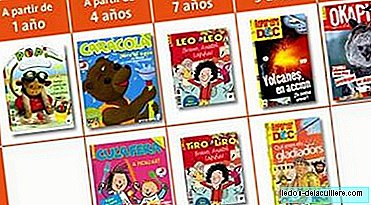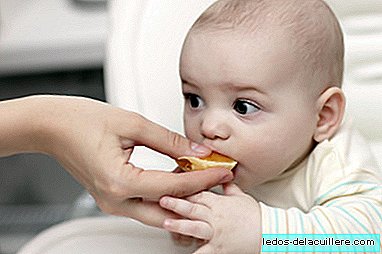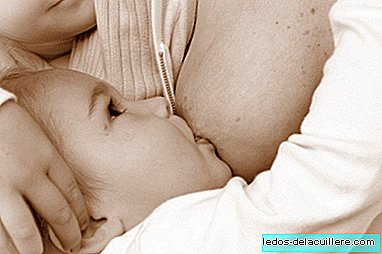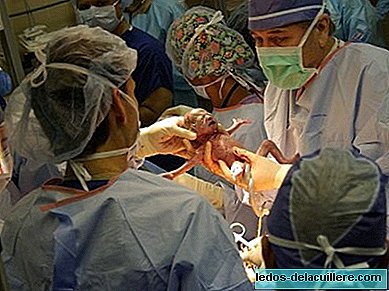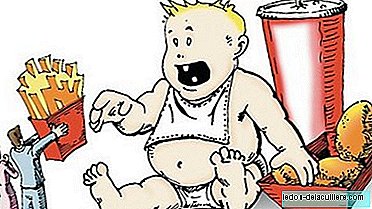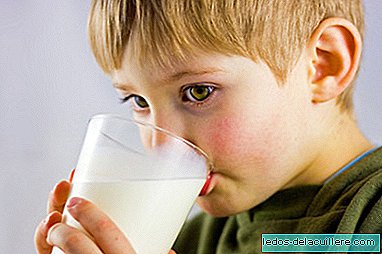
We have always heard that the healthiest diet is one in which all kinds of food come into play. That is what we want for our children, that they eat varied and, if they can also be adapted to family daily menus, much better. Of course, we must bear in mind that the nutritional needs of children 1 to 3 years of age are still somewhat different from those of adults.
We will review in this article what nutritional contribution do these kids need, in which foods are mainly nutrients and what are the recommended daily amounts.
Daily nutritional contribution in children aged 1 to 3 years
Proper nutrition is that which allows our body to stay healthy and perform vital functions normally. In this context, we find macronutrients, which mainly cover energy demands, and micronutrients in the form of minerals and vitamins.
Caloric requirements are determined based on metabolism, growth rate and age-specific energy expenditure. In this way, experts establish a range of 1,250-1,300 kcal / day for children from 1 to 3 years. In general, the amounts recommended for them of each thing are the following:
Macronutrients Carbohydrates: 50-60% (only 10% refined) / Fat: 30-35% (predominantly mono and polyunsaturated) / Animal and vegetable proteins: 10-15%
Micronutrients: Minerals. Potassium (g / d): 3.0 / Sodium (g / d): 1.0 / Calcium (mg / d): 550 / Phosphorus (mg / d): 550 / Magnesium (mg / d): 80 / Iron (mg / d ): 8 / Zinc (mg / d): 5 / Copper (mg / d): 0.5 / Iodine (µg / d): 80 / Selenium (µg / d): 20
Micronutrients: Vitamins. A (µg / d): 400 / D (µg / d): 7 / E (mg / d): 5 / K (µg / d): 12 / C (mg / d): 45 / B1 Thiamine (mg / d): 0.5 / B2 Riboflavin (mg / d): 0.7 / B3 Niacin (mg / d): 7 / B6 Pyridoxine (mg / d): 0.7 / B7 Biotin (µg / d): 10 / B12 (µg / d ): 0.8 / Folate (µg / d): 125

This contribution must be obtained through a healthy, varied and balanced diet, which forms the basis of a good eating habit once adulthood has arrived. Therefore, the foods that should be part of daily meals of children between 12 and 36 months are:
- Bread: 6 to 11 servings (slices).
- Pasta or rice: 2 tablespoons.
- Other cereals: ¼ cup.
- Vegetables: 3 to 5 portions (tablespoons).
- Fruits: 2 to 4 portions.
- Dairy products: 2 to 3 servings (½ cup of milk or yogurt or 1 slice of cheese).
- Proteins: 2 to 3 servings of meats, legumes, fish, poultry or ½ egg.
- Fats, sugars and processed products (sauces, sugars, candies, pastries or salty snacks): only sporadically and in small quantities.
Also, we must always cook in the healthiest way possible: baked, steamed, grilled, etc. To the best of our ability, we will avoid fried foods, sauces and batters.
A different menu according to age
In contrast to children, adults need to consume an average of 2,000 kcal per day, which will decrease as old age approaches. For this reason, Children's menus cannot and should not be an exact replica of those of adults.

From the age of 30, and with moderate physical activity, the main concern lies in keep calories at bay, since it tends to effect a lower energetic wear and, therefore, to gain kilos. The consumption of 0.8 g of protein per kilo of weight and day is established as a norm. The most recommended meats are those of poultry or rabbit, since they have a lower proportion of fat.
Protein foods should be combined with vegetables or fruits, which provide few calories. And the single dish, provided it contains the necessary nutrients, is much more recommended than a multi-course menu.
Lipids or fats are determinants for the neurological system, but in moderate amounts. It is essential to minimize the consumption of saturated fats and focus on unsaturated fats, which are found, for example, in olive oil and Iberian ham.
Among the unsaturated fats, Omega 3 fatty acids, especially present in bluefish, are especially recommended; and Omega 6, which are found in vegetables, cereals or seeds.
European children are lacking

The European Food Safety Authority (EFSA) states that European children ages 1 to 3 have specific nutritional needs. However, in its study on nutrient needs and dietary intake of infants and young children in the European Union, it is observed that a large number of preschoolers receive a unbalanced diet that causes a record of deficiencies in:
- DHA (docosahexaenoic acid): fatty acid of the Omega 3 group that is part of the brain and retina cells, and that helps visual and cognitive development. Blue fish - salmon, anchovies, sardines - and egg yolk are rich in DHA fats.
- Iron: mineral that favors cognitive and immune development. Our body demands it for many functions, such as maintaining healthy muscles and carrying and storing oxygen in the body. It also prevents anemia. It is found mostly in red meat and shellfish shellfish (cockles, mussels).
- Vitamin D: basic for calcium absorption and bone development. The sun's rays help synthesize it. Again the salmon and the egg yolk appear in the first posts of vitamin D, they are added orange juice.
- Iodine: an important mineral for cognitive function and nervous system development. If you look for it in the supermarket, you will find it in good quantity in iodized salt, marine vegetables (seaweed) and fresh cod.
As fundamental causes of these results, we can point to the upbringing in environments with lack of sunlight, bad eating habits, the child's resistance to taking solids, intolerances and other specific health problems such as diarrhea. For its part, the European Society of Pediatric Gastroenterology, Hepatology and Nutrition (ESPGHAN) values the use of milks with adapted formulations as "part of a strategy to increase the intake of iron, vitamin D, and PUFA n-3 and decrease the protein intake compared to un fortified cow's milk. "
How to avoid infant nutritional deficit

Of course, the goal is to promote good eating habits based on the Mediterranean diet, rich in fruits and vegetables, cooked in a healthy way and consumed in adequate, varied and balanced portions. At this point, there is a universal consensus.
However, sometimes it is difficult to get the little ones in the house ingest all the nutrients they need in the right proportions. As can be seen from the EFSA report, it is not an issue that is confined to countries in conflict or developing ways, but is given at European level due, probably, to our increasingly frenetic lifestyle, in addition to the Direct opposition of some infants to incorporate new flavors or textures into their diet.
In this sense, milk is a complete food, for daily consumption and easy access, which makes it a great ally to achieve a healthy and balanced diet that provides the elements that the child needs in the stage of his life that concerns us .
Against unmodified cow's milk, the incorporation of growth milks or adapted milks For the feeding of children from 1 to 3 years of age it is very useful, since they allow to reach the appropriate nutritional profile in a more specific way.
Not all milks are the same
The formulation of infant milk varies depending on the age group to which they are intended. Those designed for children under 1 to 3 years, especially those enriched with DHA, iron and vitamin D decrease the risk of renal overload due to its lower protein content compared to cow's milk.
They also ensure an optimal intake of monounsaturated and polyunsaturated fatty acids, as well as lower consumption of saturated fat and cholesterol. All this, in turn, contributes to reducing the risk of cardiovascular diseases in adulthood.
On the other hand, growth milks have a custom composition by different manufacturers, so that in this case they are not all the same products. Hence the importance of reviewing the labeling to detect the differences and to make the right choice. There are adapted milks that can provide a child 24 times more iron per cup than cow's milk (35% of the recommended daily amount), 44% of the recommended daily amounts of calcium and 75% of the amounts Recommended daily vitamin D, in addition to adding phosphorus and vitamins A, B1, C and E.
A product that promotes balanced diet
The conclusions of the ALSALMA study, the first Spanish analysis on dietary intake in children aged 0 to 3 years, released by the journal Acta Pediátrica reveal that, in the age range of 1 to 3 years, there is an excessive consumption of protein ( 3 times more than recommended) and insufficient AGP, vitamin D, iron and folic acid. Almost 90% of Spanish children do not ingest the recommended amounts of vitamin D, and more than 21% of iron.

Although there is currently no specific consensus recommendation from the scientific community, the truth is that in reports from EFSA, ESPGHAN and recently also from the Spanish Association of Pediatrics, growth milks are considered a useful option to contribute the key nutrients during the stage of 1 to 3 years. Obviously, they must be integrated into a varied diet. The point is that with a gesture as comfortable and simple as offering a glass of milk to a child, parents can trust that he receives the nutrients he needs without having to submit the rest of his diet to a "third grade."
Images | iStock / WaldemarMilz / olesiabilkei / Choreograph / SergiyN.


